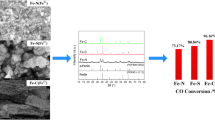Abstract
The effect of water on the performance of potassium-promoted precipitated iron catalyst was investigated during Fischer–Tropsch synthesis (FTS) using a continuously stirred tank reactor (CSTR) at two different reaction temperatures. Water was added in such a manner as to replace an equivalent amount of inert gas so that all other reaction conditions (e.g., reactant partial pressure, space velocity) remained the same before, during, and after water addition. The externally added water had a positive effect on CO conversion at 270 °C whereas, for the reaction carried out at 230 °C, the added water decreased CO conversion and deactivated the catalyst. From these findings, the addition of water at 230 °C oxidized the catalyst, transforming the iron carbide to the Fe3O4 phase. When the reaction was carried out at 270 °C, severe oxidization did not take place and a carbide phase was retained. The loss in activity and the rate of deactivation were more pronounced at 230 °C compared to the 270 °C condition for the same catalyst. Mössbauer spectroscopic measurements revealed that for the reaction carried out at 230 °C, the catalyst had 85% of the iron present as Fe3O4 and the remaining as Hägg carbide (χ-Fe5C2), whereas at the higher temperature reaction condition the catalyst had about 66% of the iron present as έ-Fe2.2C, with the remaining as Fe3O4. These findings were also supported by XANES analysis, where a high white line intensity was observed for the sealed used catalyst sample for the low temperature reaction condition, indicating a higher extent of oxidation. A low white line intensity was recorded for the used sample for the high temperature reaction condition, indicative of a higher extent of reduction.
Graphical Abstract
The effect of water on the performance of potassium-promoted precipitated iron catalyst was investigated during Fischer–Tropsch synthesis (FTS) by using a continuously stirred tank reactor (CSTR) at two different reaction temperatures. In these studies, the added water replaced an equivalent amount of inert gas so that all other reaction conditions remained the same before, during, and after water addition. The externally added water had a positive effect on CO conversion at 270 °C whereas, for the reaction carried out at 230 °C, the added water decreased CO conversion and deactivated the catalyst. From these findings, the addition of water at 230 °C oxidized the catalyst, completely transforming the iron carbide to the Fe3O4 phase. When the reaction was carried out at 270 °C, oxidization did not take place and the carbide phase was retained. The loss in activity and the rate of deactivation were more pronounced at 230 °C compared to the 270 °C condition for the same catalyst. Mössbauer spectroscopic measurements and X-ray absorption near edge spectroscopy (XANES) studies further supported these findings.









Similar content being viewed by others
References
Botes FG (2008) Catal Rev 50:471
Karn FS, Shultz JF, Anderson RB (1961) Actes Congr Int Catal 2:2439
Satterfield CN, Hanlon RT, Tung SE, Zou ZM, Papaefthymiou GC (1986) Ind Eng Chem Prod Res Dev 25:407
Summerford SD (1950) US Patent 2,497,964, February 21
Bell WK, Haag WO (1990) US Patent 4,978,689, December 18
Reymond JP, Meriaudeau P, Pommier B, Bennett CO (1980) J Catal 64:163
Luo M, O’Brien RJ, Bao S, Davis BH (2003) Appl Catal A: Gen 239:111
Zhao G, Zhang C, Qin S, Xiang H, Li Y (2008) J Mol Catal A: Chem 286:137
Ronald D, Bell AT (1986) J Catal 97:121
Arakawa H, Bell AT (1983) Ind Eng Chem Res Proc Des Dev 22:97
Ribeiro MC, Jacobs G, Davis BH, Cronauer DC, Kropf AJ, Marshall CL (2009) AIChE annual meeting Nov 8–13, Nashville, TN, USA
Li S, Li A, Krishnamoorthy S, Iglesia E (2001) Catal Lett 77:197
Li S, Ding W, Meitzner GD, Iglesia E (2002) J Phys Chem B 106:85
Li S, Krishnamoorthy S, Li A, Meitzner GD, Iglesia E (2002) J Catal 206:202
Ressler T (1997) WinXAS 97, version 1.0
Anderson RB (1956) In: Emmett PH (ed) Catalysis, vol IV. Reinhold Publishing Corporation, New York, Chap. 3
O’Brien RJ, Xu L, Spicer RL, Davis BH (1996) Energy Fuels 10:921
Dry ME (1981) In: Anderson JR, Boudart M (eds) Catalysis-science and technology, vol 1. Springer-Verlag, New York, pp 196–198
Luo M, Davis BH (2003) Fuel Process Tech 83:49
Niemantsverdriet JW, van der Krann AM, van Dijk WL, van der Baan HS (1980) J Phys Chem 84:3363
Butt JB (1990) Catal Lett 7:61
Acknowledgments
This work was supported by the Commonwealth of Kentucky and a grant from the Kentucky Governor’s Office of Energy Policy Energy Research and Development Program entitled “Towards understanding how alkali promoters alleviate CO2 production and enhance chain growth probability over iron Fischer–Tropsch synthesis catalysts.”
Author information
Authors and Affiliations
Corresponding author
Rights and permissions
About this article
Cite this article
Pendyala, V.R.R., Jacobs, G., Mohandas, J.C. et al. Fischer–Tropsch Synthesis: Effect of Water Over Iron-Based Catalysts. Catal Lett 140, 98–105 (2010). https://doi.org/10.1007/s10562-010-0452-7
Received:
Accepted:
Published:
Issue Date:
DOI: https://doi.org/10.1007/s10562-010-0452-7




